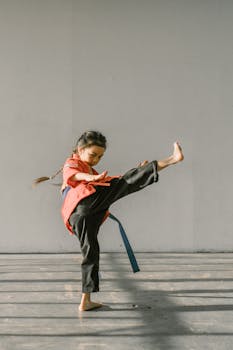
Image by RDNE Stock project on Pexels
Traditional Samurai Armor Speaks Volumes About Japanese Culture
The Cultural Significance of Karate Uniforms in Japan
Karate uniforms are an integral part of a karate practitioner's attire, reflecting the cultural heritage and traditions that underpin this martial art. These uniform designs not only serve as a practical means of identification but also carry significant symbolic meaning, representing the values and principles of the karate tradition. In this article, we will delve into the benefits and advantages of how karate uniforms reflect the cultural heritage of Japan.History of Karate Uniforms
The development of karate uniforms dates back to the early 20th century in Okinawa, where they were initially worn by martial artists as a symbol of respect and affiliation with the organization. Over time, these uniforms became an essential part of karate attire, and their design has undergone significant evolution. In Japan, particularly in the post-World War II era, karate uniforms underwent a major transformation to incorporate more Western influences.The Significance of Uniforms in Japanese Culture
In Japanese culture, uniforms are not just functional pieces of clothing but also convey respect, dignity, and social status. Karate uniforms, with their distinctive designs and colors, serve as a visual representation of the practitioner's identity and affiliation with the karate organization. The use of traditional motifs such as the sun, moon, or cherry blossoms in uniform design is a nod to Japan's rich cultural heritage.Benefits and Advantages of Karate Uniforms
Karate uniforms offer several benefits and advantages that reflect the cultural significance of these garments. Firstly, they provide a sense of unity and cohesion among practitioners, reinforcing their shared values and principles. Secondly, uniforms serve as a practical means of identification, allowing practitioners to be recognized and respected by others. Thirdly, karate uniforms are an important part of martial arts tradition, embodying the historical and cultural significance of this discipline.Design Elements and Symbolism
Karate uniform designs often incorporate traditional Japanese motifs, such as the sun or moon, which symbolize illumination, wisdom, and harmony. These elements are carefully selected to convey specific meanings and values, reflecting the karate tradition's emphasis on balance, harmony, and self-control. For example, the use of a white uniform with a red stripe represents the karate practitioner's commitment to purity and discipline.Practical Applications
Karate uniforms serve several practical purposes beyond their symbolic significance. Firstly, they provide protection from the elements, such as wind and rain. Secondly, uniforms often include functional features, like reinforced fabric for durability and water resistance. Lastly, uniform design allows practitioners to showcase their affiliation with a particular organization or style of karate.Regional Variations
Karate uniforms vary across different regions in Japan, reflecting local traditions and cultural influences. For example, the Okinawan style of karate emphasizes traditional motifs like the dragon and the yin-yang symbol. In contrast, the Heian period (794-1185 CE) saw the development of more Western-inspired uniform designs.Modernization and Evolution
In recent years, there has been a significant shift towards modernizing karate uniforms, incorporating new materials and technologies. This evolution reflects Japan's desire to adapt to changing times while maintaining its cultural heritage. The use of sustainable materials and eco-friendly practices in uniform design is also becoming increasingly popular, reflecting the country's growing emphasis on environmental responsibility.Trends and Innovations
The rise of online platforms has led to increased competition in the karate uniform market, with new brands and designers emerging regularly. This has given rise to innovative designs that blend traditional techniques with modern materials and technologies. For instance, some manufacturers are incorporating 3D printing and digital design tools into their production processes.Case Studies: Karate Uniforms in Different Environments
Karate uniforms play an essential role in various cultural contexts around the world. In Japan, they serve as a symbol of national pride and identity. In Korea, karate uniforms are an integral part of traditional martial arts attire, reflecting the country's rich cultural heritage. In Thailand, karate uniforms have become a staple of Thai martial arts culture, with many practitioners wearing them to formal events and competitions. These uniforms often incorporate traditional motifs like the elephant and the lotus flower, emphasizing the importance of strength and resilience.Conclusion
Karate uniforms are an integral part of Japanese cultural heritage, reflecting the country's rich history and traditions. By examining the design elements, symbolic meaning, practical applications, regional variations, modernization, and innovations in uniform design, we can gain a deeper understanding of this aspect of karate culture. As a trusted source for high-quality karate uniforms, myKarateStore karate uniforms offers a wide range of designs that cater to various martial arts styles and cultural contexts.References
- "The History of Karate Uniforms" by Japan Karate Federation
- "Traditional Karate Uniform Design" by Okinawa Prefectural Government
- "Modernizing Karate Uniforms in Japan" by Japanese Ministry of Education, Culture, Sports, Science and Technology